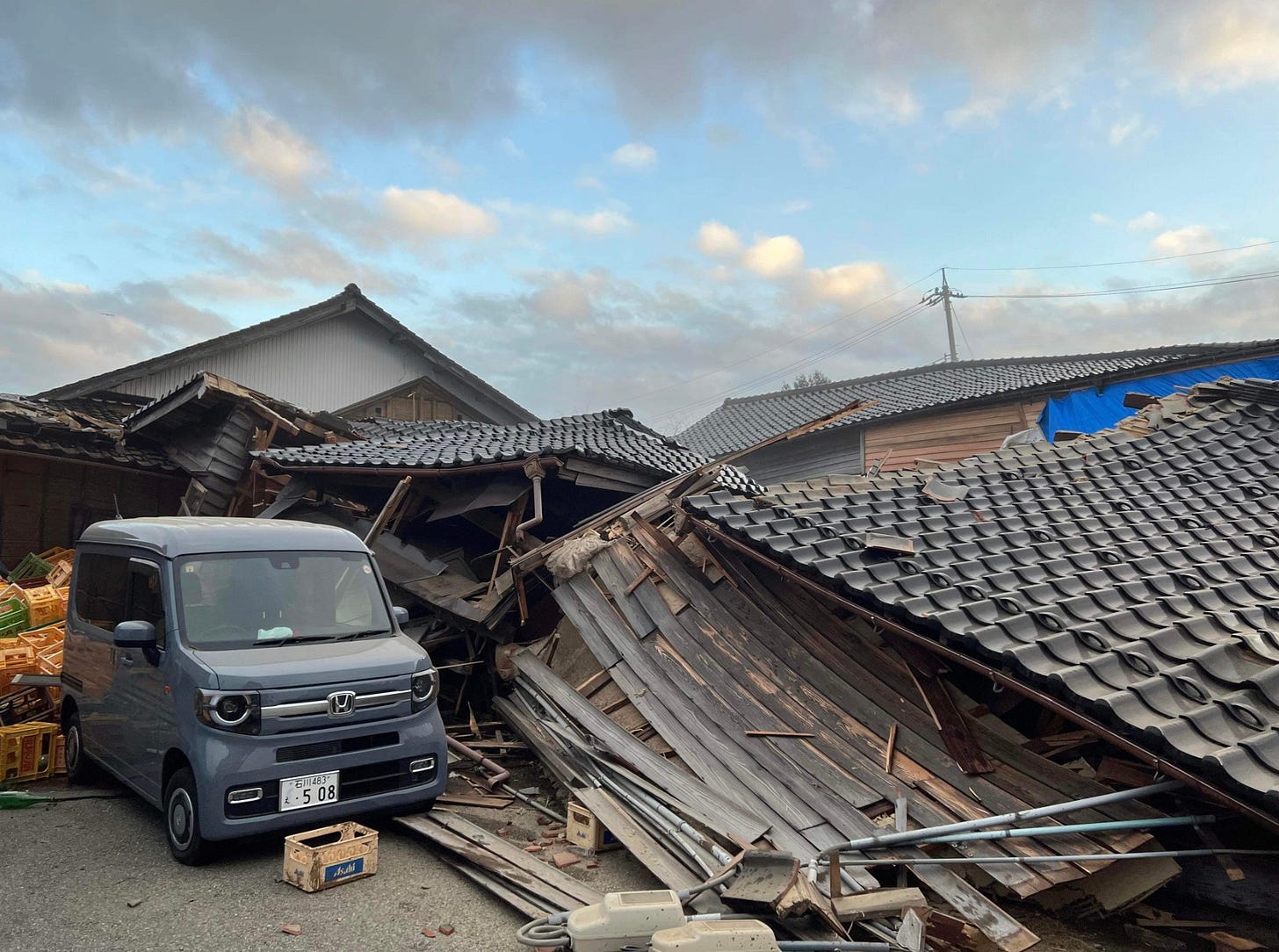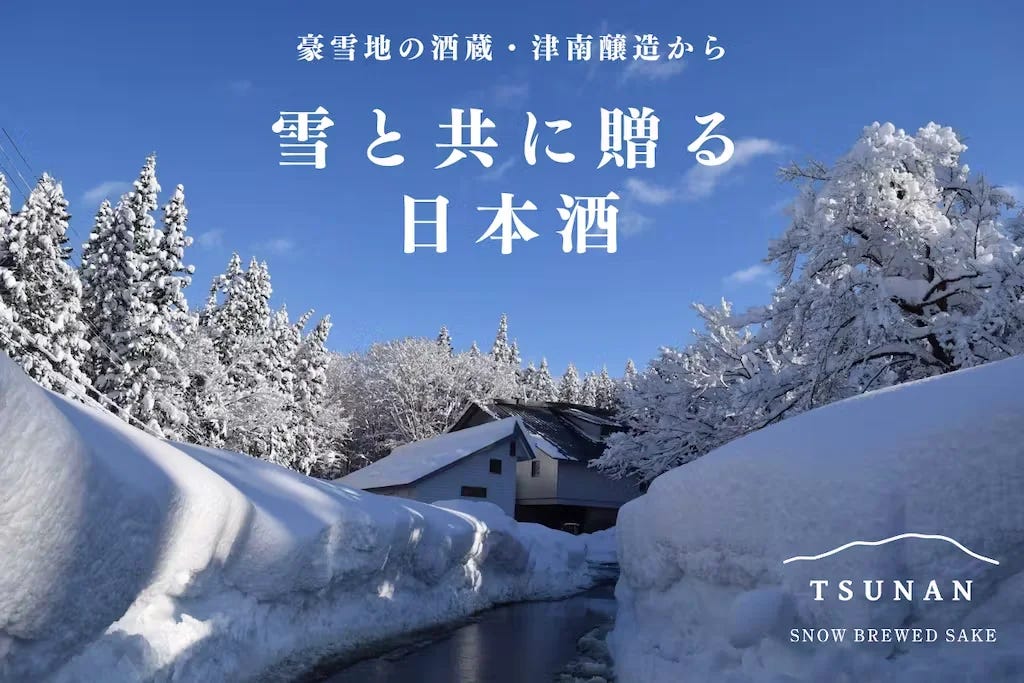Sake Industry News. Issue #104.
Ishikawa Earthquake Report, Adachi Nōujō, Makino Shuzō launches distillery, Tanabe Takeshita Shuzō launches Rihachi, 2024 forecast and more!
Welcome to Issue #104 of SIN.
*Please note - no audio/ podcast on this issue due to logistical reasons.
As readers would be well aware, 2024 didn't start off well for Japan with a major earthquake causing major damage and sparking evacuations amid a looming threat of a potential tsunami.
The disaster presented yet another reminder of the fragility and reality of life in a country prone to such disasters. The earthquake affected residents and businesses across Ishikawa, Toyama, Niigata, and other regions, and of course meant sake breweries were also part of the fallout.
To describe the aftermath by saying," it could have been worse," will provide little comfort to those that lost family, friends, homes and businesses, but the reality is the earthquake was handled well and an efficient response from rescue services helped to ensure that fatalities, injury and property loss were averted as much as possible.
As we always say in these dark times, the best thing we can do to help the breweries affected by the disaster is buy their product and keep them alive (although monetary support is also an option - see below).
And now for the news...
Ishikawa Earthquake Report
Ishikawa- As mentioned at the top of this newsletter, an earthquake measuring 7.6 magnitude struck the Noto Peninsula off the coast of Ishikawa Prefecture on January 1 at 16:10 JST.
Large tremors were observed in many surrounding areas and a tsunami warning was issued resulting in evacuations across the coast. Following the initial quake, up to 1320 aftershocks were recorded nearby. Damage was reported along the coast in Niigata, Toyama, Fukui and Hyogo Prefectures.
To date, 215 deaths and 675 injured have been reported. No loss of life has been reported from any sake breweries.
The ensuing tsunami damaged at least 100 hectares in Suzu City and Noto City. Power and water supplies were cut and communications severely disrupted.
Many districts were isolated with roads cut off and food, water, blankets and fuel, and basic needs still in short supply.
Further damage resulted when the quake caused fires in Wajima. It is estimated more than 11000 houses were damaged or destroyed in the region. Many sake breweries were affected by the earthquake with some of the information gathered listed below:
Hara Shuzō (Koshino Homare) reported cracks in the 200 year-old kura. Tanks were jostled and a number of bottles damaged.
Matsunami Shuzō (Ōeyama) reported the kuramoto family home as well as the brewery was destroyed. The family was forced to take refuge at a local junior high school along with 600 other local residents.
Mikawa Shuzōjō (Maibijin) in Fukui reported cracks in the brewery structures but no severe damage.
Takachiyo Shuzō in Niigata reported tank leakage, however bottles were secured.
Abe Shuzō (Niigata) reported a loss of more than 2000 bottles. The brewery already had earthquake countermeasures in place such as height limits on stacking and securing bottle stacks with rope.
Takeda Shuzōten (Katafune) in Niigata reported loss of a number of bottles.The brewery has also been forced to abandon plans for the release of 15-year aged daiginjō sake that was only in its sixth year of maturation.
Nakajima Shuzōten (Noto Suehiro) reported loss of a significant amount of sake in storage and production as well as severe structural damage.
The following Noto breweries reported complete destruction of all brewing facilities:
Matsunami Shuzō (Ōeyama)
Tsuruno Shuzō (Tani Izumi)
Hakutō Shuzō (Shiragiku)
Sakurada Shuzō (Taikei)
Hiyoshi Shuzōten (Kinpyo Shiarkoma)
The following breweries reported structural damage and partial collapse of buildings:
Sōgen Shuzō (Sōgen)
Hakutō Shuzōten (Shiragiku)
Kazuma Shuzō (Chikuha)
Nakano Shuzō (Noto Kame Izumi)
Shimizu Shuzōten (Noto Homare)
Nakano Shuzō (Wakamidori)
For those that wish to donate, a fund has been set up online (access link here) to help the sake breweries struggling at this impossibly difficult time.
Or you can donate directly by bank deposit to an account set up especially for donations by the Ishikawa Sake Brewers Association:
(https://www.ishikawa-sake.jp/images/97-1.pdf)
(BANK) THE HOKKOKU BANK,LTD (from within Japan bank number 0146)
(BRANCH) KANAZAWAJYOHOKU BRANCH (within Japan branch number 119)
(SWIFT CODE) HKOKJPJT
(ACCOUNT NO.) 119-0036977 (within Japan 036977)
(NAME) ISHIKAWAKENSHUZOUKUMIAIRENGOUKAI
(ADDRESS) 2-13-33, Motomachi, Kanazawa, Ishikawa, 920-0842, Japan
Sources - PR Times, NHK, Yahoo, Yahoo
JG: It is hard to find words to properly express condolences for the scale of destruction, and while the loss of life was mercifully low, every life lost matters. Reports are that 11 breweries have had to cease operations for this season, and that figure includes the five that were completely destroyed. Perhaps the most commonly encountered of these are the producers of Okunoto Shiragiku (which was completely destroyed) and Sōgen (which suffered structural damage). While it is hard to predict which will survive or be rebuilt, let us pray for and hope for a recovery miracle for the sake industry in Ishikawa, but equally for all industries and individuals affected by this calamity. Please consider donating money to one of the funds that can help with that recovery.
原酒造 (越の誉), 松波酒造 (大江山), 美川酒造場(舞美人), 高千代酒造 , 阿部酒造 (あべ), 竹田酒造店(かたふね), 中島酒造店 (能登末廣), 鶴野酒造 (谷泉),
白藤酒造(奥能登の白菊), 櫻田酒造(大慶), 日吉酒造店(金瓢白駒), 宗玄酒造
, 数馬酒造(竹葉), 中野酒造(能登亀泉), 清水酒造店(能登誉),中納酒造(若緑)
Craft Sake Comes To Osaka
Osaka- As reported back in SIN#85 Osaka became home to its first craft sake brewery early 2023 with the arrival of Adachi Nōujō in the northeastern city of Takatsuki. Now, the brewery is open for business and ready to serve up its own brand of craft sake produced by Yoji Adachi.
The brewery is located in an old housing complex only 33 square meters in size, but large enough to house a complete brewery setup including a kōji room, fermentation tanks, pressing machine and a pasteurization machine.
Yōji Adachi cut his teeth brewing at Hachinohe Shuzō (Mutsuhassen) in Aomori and Nishiyama Shuzōjo (Kotsuzumi) in Hyogo before branching out with his own brewing project. Initially, he worked with reviving abandoned rice paddies to harvest table rice for use in sake he brewed by renting tanks at other breweries as “phantom brewer”.
The new brewery and bar/cafe space offers guests light snacks and sake produced by Adachi as well as sake from his former employers.
Source - Asahi
足立農醸 , ADACHI NOUJO Craft Sake Brewery , 八戸酒造(陸奥八仙), 西山酒造場 (小鼓)
New Sake Under New Management
Shimane- Tanabe Takeshita Shuzō has launched its new sake label since being succeeded by the Tabe Group and rebranded from its former trading name, Takeshita Honten.
The new label, Rihachi, was unveiled at a launch party at the brewery.
Tabe Takeshita Shuzō was established in June 2023, and is known as the family home of former Prime Minister Noboru Takeshita, who took over the brewing business following his years in office.
The new label marks the return of the Tanabe family, which actually sold the business to the neighboring Takeshita family 150 years ago. Rihachi was the name of the head of the Takeshita family at the time. The name was bestowed in honor of his passion for sake brewing and as a showing of respect to the Takeshita family for its role in preserving the brewery.
Rihachi junmai ginjō is available in two formats - a white label and a black label, each made with a different yeast strain (1701 and 1801 respectively).
A total of 16,000 bottles will be released across the country through recognized sake distributors.
Source - FNN
竹下本店 , 田部竹下酒造 , 理八
Gunma's Oldest Kicks Out The Drams
Gunma- Makino Shuzō, the oldest operating sake brewery in Gunma Prefecture, founded in 1690, has branched out into whiskey production.
The brewery has launched Kurabuchi Distillery and produced its first single-malt whiskey called Kurabuchi - NEW MAKE-. The cask strength whiskey was released on the market on December 21. The launch marks a new challenge for the long-established brewery, well known for Ōsakazuki and Macho labels.
Makino Shuzō joins a number of sake breweries that have expanded to whiskey distilling including Chugoku Shuzō (now Sakurao Brewery & Distillery), Wakatsuru Shuzō (Toyama) and Umegae Shuzō (Nagasaki) among others.
More breweries are entertaining the idea of moving into spirit production as overall sake consumption continues to drop from its peak of 1.6million kiloliters 50 years ago to 400,000 kiloliters in 2021. Meanwhile, whiskey domestic consumption sat at 75,000 kiloliters in 2008 and had doubled to 168,000 kiloliters by 2021.
牧野酒造(大盃), 倉渕―New Make- , 竹鶴酒造 , 若鶴酒造 , 梅ヶ枝酒造
Industry Stirrings...
Niigata- Tsunan Jōzō is located in an area of Niigata Prefecture where heavy snowfall of 3 to 4 meters is just a given part of daily life. The brewery uses melted snow water in its brewing and the frosty atmosphere provides natural refrigeration for the brewery. Now, the brewery has decided to share this feature of its environment with the release of its Gōsetsu Set.
The Gōsetsu Set features three bottles of "Tsunan snow-brewed sake” and is cool-delivered packed with actual snow for JPY8800.
GO DINER junmai daiginjō 720ml (Gohyakumangoku)
GO DOLCE junmai ginjō 720ml (Gohyakumangoku)
Tsunan Ōgon shiboritate muroka namagenshu junmai 720ml (Gohyakumangoku)
Source - PR Times
津南醸造 , 郷雪セット(郷(GO) DINER純米大吟醸、郷(GO) DOLCE 純米吟醸、つなん黄金搾りたて無濾過生原酒 純米酒), 五百万石
New Year Hopes & Ten Predictions For 2024
By John Gauntner
While I chose not to close 2023 with a look back over the year, I would like to open the new year with some predictions for 2024. Some of these are a bit obvious, but worth pointing out nevertheless. Others are more interesting, being things about which we might not normally hear, but significant to those of us that simply must know everything about sake.
With no further ado…
More outsourced sake products.
While I am personally not so interested in such products, there has been a recent increase in companies with marketing and sales prowess asking sake breweries in Japan to make a sake for a private label that might target a particular demographic, region, or both. For the most part, this can be win-win, but with so many sake directly from importers available everywhere, it will continue to be challenging to get traction and sustain growth. But all those that get involved are confident that it can be done, and that spirit is so alive and well that I expect this trend to continue for a while. I do, however, see an upper limit to how much this sector can expand or grow.
More collaborations with wine world luminaries
This is of course closely related to the first prediction, but such VIPs contribute not only their finely honed technical skills and sensibilities, but also their branding. However, I do see a limit to how many such products the market can support, so while I expect to see a few more in the future, infinite growth is not in the cards. I personally do not see a huge advantage in collabs or extravagant packaging that takes attention away from the producer. When I encounter such products, I always look for the name of the producer. But that’s just me; not everyone feels the same way.
USA to return as top import market
This is a bit of a “Captain Obvious” prediction, but China, the current largest importer monetarily at least, and in some statistical snapshots volume-wise as well, will likely drop back a step for economic and political reasons. The economy is huge, but so then is the power of events and circumstances that affect that economy. However (there is always a “however”), China will be back soon enough in both sake import value and volume.
Increase in sake competitions
This is another one I do not really get since, as far as I can see, it is not an easy thing to start up and run, and it takes a few years to get a reputation and traction. But new contests pop up all the time, and I expect that to continue for a while. But it is all good as it give sake more exposure and in a positive light. However (there it is again!), there will surely be a shakeout in time.
Aruten sake will continue to decline
As many readers well know, “aruten” is sake slang for non-junmai, or anything that has had distilled alcohol used in its production. That would include anything that does not have the word “junmai” in the name, i.e. futsu-shu, honjozo, ginjo and daiginjo.
There is no turnaround in sight, really. The junmai types continue to grow, and the non-junmai types continue to contract. It is a bit of a shame as the step of adding a bit of distilled alcohol can really enhance a sake.
I think the choice of the term “junmai” long ago is part of the problem. It translates as “pure rice”, implying that anything that is not junmai is impure. It is hard to fight that stigma.
Note, though, that most of the alcohol that is added, while it is not much, is initially distilled from sugar cane, mostly from Brazil. So, it is not made from rice, and is not even sourced in Japan. As such, the only concession I make is that the junmai types have much more traceability, and are made with materials that are all from Japan. But still… aruten sake can taste so good…
Some have proposed using cheap rice to make that alcohol, which would solve that problem, but as of yet it is too expensive to be a realistic option. Perhaps sometime in the future that will change; who knows?
Improvement in distribution
I have been pleasantly surprised by seeing so many sake brands of which I have never heard suddenly available. Of course, ecommerce has helped so much on that front. Stuff I never knew existed is coming out of the woodworks, so to speak.
But also, in an effort to develop new distribution channels, many medium to large breweries are starting (or reviving) brands of sake that are slightly different from their main lines.
It’s not really a problem. On the contrary, it is kind of cool in that it allows us to get excited about something new when we come across such brands. I have to admit, I feel a l’il spark o’ joy when I find a sake I have not had before.
Note, it is not the overall amount of sake that is increasing, just the number of readily available brands. However (!), the market will not be able to support them all over the long run. So that shakeout will happen in some form as well. But for now, it’s fun.
Overall consumption will go up for the first time in years
Sake shipments were basically flat over the past couple of years, which is better than one of the alternatives, a further decrease that is a continuation of a slide that has been happening since 1973. But we can expect a rebound as things have stabilized since the COVID slowdown. So I do expect an increase in the calendar year 2024, as well as the Brewing Year (July to the next June) and the Fiscal Year (April to the next March) too. However, it might not continue in 2025. So let’s not get too excited yet.
Packaging will continue to improve, i.e. “more cooler labels”
While not as easily measurable as some other metrics, many breweries seem to be overhauling the image of their labels. Traditional label designs can be great, but there is a fine line between timeless tradition and just plain old and stodgy. Lately I am seeing more and more fresh and cool designs that manage to be modern and appealing, while maintaining some gossamer connection to traditional Japanese artistic nuances. I think this is a very leveraged thing to do, and easy to implement.
Wider use of henpei or genkei methods
These two methods, which call for special equipment or jury-rigging existing machines, remove more fat and protein from the rice from the places on the grain where it is more plentiful. That means more fat and protein are removed with less milling. And it is increasingly accessible to brewers. More on this in an upcoming issue.
Global warming impact
GW will continue to cause more changes in the sake world, in particular in rice production and procurement.
It is inevitable. More on this in an upcoming issue too.
The bar will continue to rise for sake breweries outside Japan
This too is inevitable, and when the changes come they will come quickly and be clearly noticeable. Sake brewers in the US in particular but all over the world are working hard at their quality and it is showing. Next, if they learn to be profitable too, we can expect even more great things from overseas sake producers.
While not all these changes will happen, certainly others not predicted here will manifest as well. Hopefully, sake’s rebound will continue; if nothing else, let’s hold out for that.









